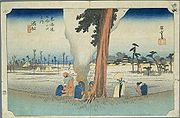
Hamamatsu-juku
Encyclopedia

53 Stations of the Tokaido
The are the rest areas along the Tōkaidō, which was a coastal route that ran from Nihonbashi in Edo to Sanjō Ōhashi in Kyoto.-Stations of the Tōkaidō:...
(shukuba
Shukuba
were post stations during the Edo period in Japan, generally located on one of the Edo Five Routes or one of its sub-routes. They were also called shukueki . These post stations were places where travelers could rest on their journey around the nation...
) of the Tōkaidō
Tokaido (road)
The ' was the most important of the Five Routes of the Edo period, connecting Edo to Kyoto in Japan. Unlike the inland and less heavily travelled Nakasendō, the Tōkaidō travelled along the sea coast of eastern Honshū, hence the route's name....
. It is located in what is now Hamamatsu
Hamamatsu, Shizuoka
is a city located in western Shizuoka Prefecture, Japan. On July 1, 2005, the city merged with 11 surrounding cities and towns. It became a city designated by government ordinance on April 1, 2007.- History :...
's Naka-ku
Naka-ku, Hamamatsu
is one of seven wards of Hamamatsu, Shizuoka, Japan, located in the central part of the city. It encompasses the site of Hamamatsu Castle and Hamamatsu Station, the central business district and a number of high density residential areas. Although its area is the smallest of the seven wards of...
in Shizuoka Prefecture
Shizuoka Prefecture
is a prefecture of Japan located in the Chūbu region on Honshu island. The capital is the city of Shizuoka.- History :Shizuoka prefecture was formed from the former Tōtōmi, Suruga and Izu provinces.The area was the home of the first Tokugawa Shogun...
, Japan
Japan
Japan is an island nation in East Asia. Located in the Pacific Ocean, it lies to the east of the Sea of Japan, China, North Korea, South Korea and Russia, stretching from the Sea of Okhotsk in the north to the East China Sea and Taiwan in the south...
.
History
During the Tenpō eraTenpo
was a , also known as Tempō, after Bunsei and before Kōka. The period spanned the years from December 1830 through December 1844...
(1830-1844), Hamamatsu-juku was located in Hamamatsu Castle
Hamamatsu Castle
is a reconstructed hirayama-style Japanese castle. It was the seat of various fudai daimyō who ruled over Hamamatsu Domain, Tōtōmi Province, in what is now central Hamamatsu, Shizuoka Prefecture, Japan...
's castle town
Castle town
A castle town is a settlement built adjacent to or surrounding a castle. Castle towns are common in Medieval Europe. Good example include small towns like Alnwick and Arundel, which are still dominated by their castles...
. At the time, there were six honjin
Honjin
thumb|250px|The honjin at [[Inaba Kaidō]]'s [[Ōhara-shuku]]. is the Japanese word for an inn for government officials, generally located in post stations during the later part of the Edo period.-Evolution of Honjin:...
and 94 hatago
Hatago
were Edo period lodgings for travelers at shukuba along the national highways, including the Edo Five Routes and the subroutes. In addition to a place to rest, hatago also offered meals and other foods to the travelers...
for travelers to use, making it the largest post station in Tōtōmi
Totomi Province
was a province of Japan in the area of Japan that is today western Shizuoka Prefecture. Tōtōmi bordered on Mikawa, Suruga and Shinano Provinces. Its abbreviated form name was .-History:...
and Suruga
Suruga Province
was an old province in the area that is today the central part of Shizuoka prefecture. It was sometimes called . Suruga bordered on Izu, Kai, Sagami, Shinano, and Tōtōmi provinces; and had access to the Pacific Ocean through Suruga Bay.-History:...
provinces. At the time, it was located on the right bank of the Tenryū River
Tenryu River
The is a river arising from Lake Suwa in Okaya, Nagano Prefecture, grazing Aichi Prefecture and flowing through western Shizuoka Prefecture in central Honshū, Japan. With a length of , it is Japan's ninth longest river.-Geography:...
, but, over time, the river's course changed, so the post station is now approximately six kilometers from the river's edge.
The classic ukiyoe print by Ando Hiroshige (Hoeido edition) from 1831-1834 depicts a rural scene with Hamamatsu Castle and the town in the far distance. A group of peasants are warming themselves by a bonfire, with a traveler looking on.
Further reading
- Carey, Patrick. Rediscovering the Old Tokaido:In the Footsteps of Hiroshige. Global Books UK (2000). ISBN 1901903109
- Chiba, Reiko. Hiroshige's Tokaido in Prints and Poetry. Tuttle. (1982) ISBN 0804802467
- Taganau, Jilly. The Tokaido Road: Travelling and Representation in Edo and Meiji Japan. RoutledgeCurzon (2004). ISBN 0415310911

